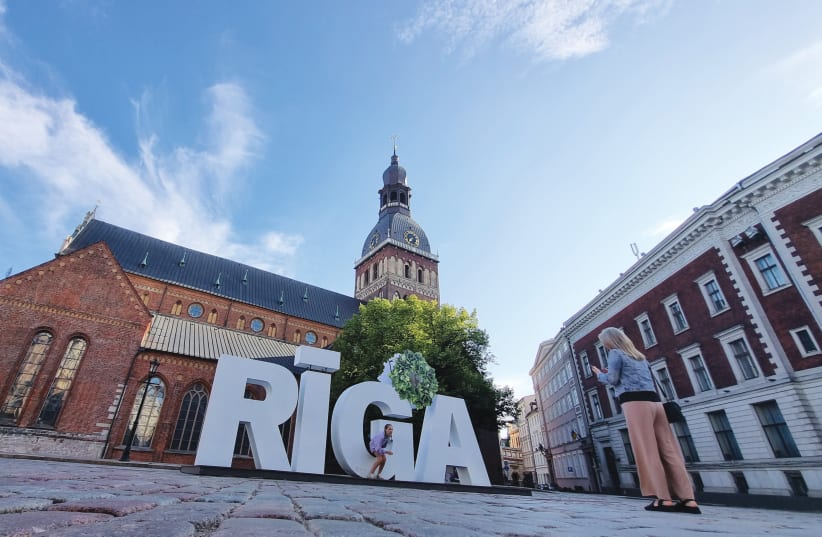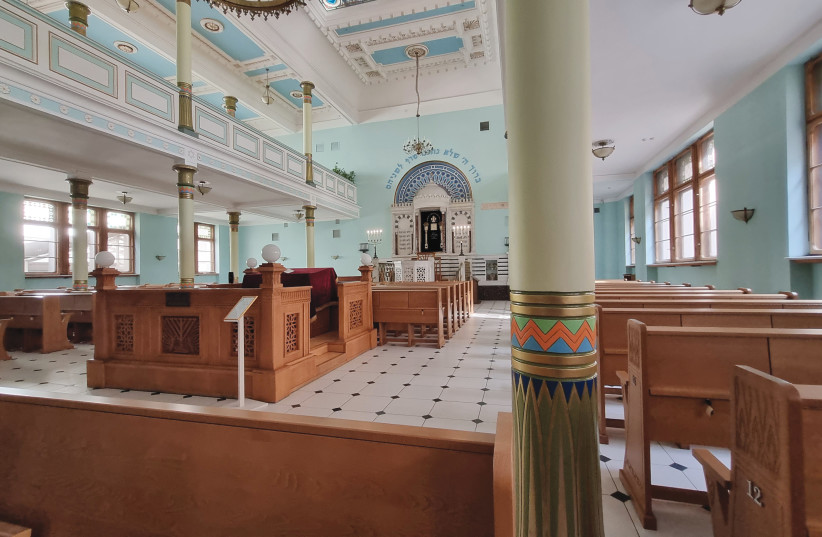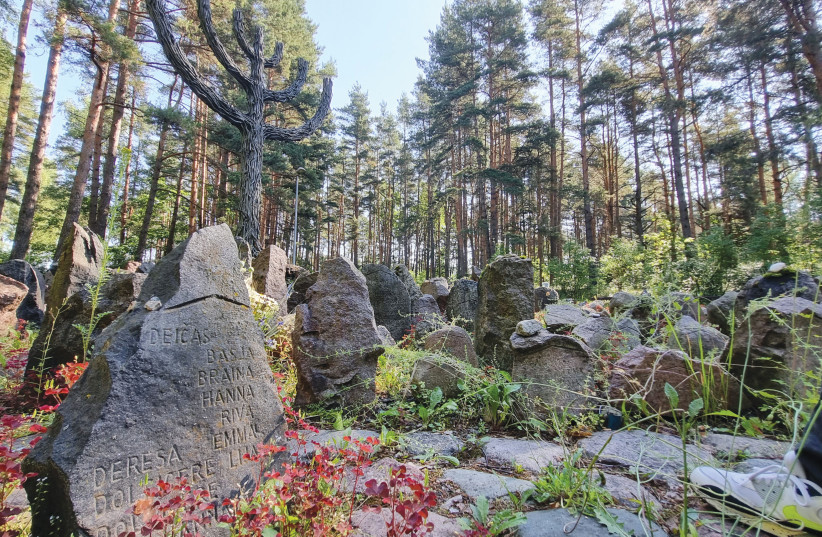Riga, Latvia’s gorgeous, compact capital is a mere 800 years old – largely built with the arrival of the Germanic Hanseatic League, accompanied by Crusaders, bringing commerce and Christianity, respectively.
It took another 300 years for the founding of the Jewish settlement in Riga.
By then, today’s old town was already beginning to take shape with still-extant churches, merchant homes, and narrow lanes, creating a compact and then-fortified city.
But Latvian independence only came about in 1918 and lasted for just two decades after centuries of foreign rule. That freedom was cut short abruptly by German occupation before becoming part of the Soviet Union, until full independence in 1991.
As freedom is a relatively new concept for this small nation, Latvians are fiercely proud of their accomplishments, like the art nouveau architecture of Mikhail Osipovich Eisenstein, the invention of jeans by Riga-born Jacob W. Davis, and the sporting success of NBA star Kristaps Porzingis.
National museums, historic buildings, and fine restaurants abound in a downtown abutted by fine parks, a boating canal, and a never-ending indoor and outdoor market.
The latter perhaps presents a microcosm of life in the capital.
“Sure there are babushkas here but young people flock to the market for the best vegetables, cheeses, and meats,” says Vilija Malinauskaite, CEO of Jewish Travel Latvia. Eels, herring, and salmon abound behind gleaming glass counters. Cottage cheese curd is served from huge plastic containers with ubiquitous multicolored jars of healthy oils and mixed pickles on display.
The indoor section is housed in what were once Zeppelin hangars. That German influence was never far away and it dealt a heavy blow to the local Jewish community during the Holocaust. Some 70,000 were murdered, three-fourths of the Jewish population.
The remarkable Riga Ghetto and Latvian Holocaust Museum tells their story. Located half a mile from the still-standing Riga Ghetto, the museum is the life’s work of Rabbi Dr. Menachem Barkahan, supported by many dedicated hands.
“It’s not about death, rather celebrating life,” says Barkahan, who chairs the board of the museum. “Of the 200,000 visitors so far, 20% to 30% have been Latvian schoolchildren.”
The constantly-growing exhibition features personal stories, recreations of destroyed synagogues, and a wooden home moved in its entirety from the ghetto.
Barkahan, whose father was Latvia’s chief rabbi, says he has approval for a major expansion of the museum and hopes it will help foster understanding and tolerance between peoples.
The road from Riga to Liepaja is long, straight, and flat. Liepaja is a beautiful resort city with stunning white sand beaches that stretch all the way to Lithuania. There are parks and concert venues surrounded by gorgeous pre-war stone homes alongside smaller wooden abodes built prior to the horrors of the Holocaust. Before the war, there were 7,000 Jews in Liepaja, or Libau, as older citizens remember it. By 1945, only 25 remained.
The deeds of 26 righteous gentiles are commemorated alongside a memorial to thousands of Jews and others, shot on the Skede sand dunes just outside town.
The Shoah is never far away.
Former Latvian prime minister Maris Gailis wanted to tell a particular story from the Holocaust period – that of righteous gentile Janis Lipke and his wife, Johana. They saved some 60 Jews by hiding them beneath their home. Gailis’s wife, Zaiga, an award-winning architect, designed the Noah’s Ark-like Lipke Memorial on the Riga riverside. The museum is simple, yet powerful.
On the edge of Riga, not too distant from the old Jewish cemetery, destroyed by the Soviets, is one of the starkest reminders of the Holocaust anywhere in Europe.
It’s a pleasant stroll through the woods at Rumbula. Until one arrives in a relatively small clearing. There are a few raised grassy areas, a large sculpted menorah, and a series of rough-cut stones about a foot high with dozens of names carved into their frontages. On this spot, some 25,000 Jews were shot and buried where they fell. Tour guide Peter (one-quarter Jewish) says he still can’t come to terms with what occurred here. As a teacher he brought hundreds of 10- to 12-year-old Latvians to this place.
“Imagine you went for a walk and were told you would never see your parents and grandparents again,” he would tell his young wards.
Riga tours
THE TOUR guide at Rundale Palace has a much easier job than Peter. Built in two periods, from 1736 until 1740 and from 1764 until 1768, the Baroque and Rococo home is around a 90-minute drive from the capital. Initially, it was the summer residence of the Duke of Courland but with the expansion of the Russian Empire, Catherine the Great presented the palace to Count Valerian Zubov, the youngest brother of her lover, Prince Platon Zubov.
The modern-day Latvian jet-sets for swanky Jurmala. The resort lies just 30 minutes from Riga and is perfect for an evening out or a weekend away. There’s water-skiing, boat trips, pristine sand, incredible food, and awe-inspiring sunsets. There is a synagogue close to another beach. It’s so fancy, that the Jewish locals refer to the beit knesset as the “Millionaire’s Synagogue.”
After all this history, regal and tragic, perhaps a trip to Latvia is best concluded with a visit to today’s Jewish community – probably a little under 7,000 souls – the majority in Riga.
The Peitav Synagogue, the only shul to survive the war, lies in the old town, down an unremarkable lane. The outer courtyard is modest to say the least, as is the vestibule. But the synagogue itself is an architectural monument of national significance. The 120-year-old synagogue was designed by architect Wilhelm Neumann in an art nouveau style. It’s a bright, airy space, with women’s galleries running down both sides. The compound includes a mikveh and a covered inner courtyard that acts as a dining area and sukkah. With advance notice, the synagogue can arrange meals for visitors.
And then of course there is Chabad. After some time in a temporary structure, the organization now operates from a downtown purpose-built space. Most of the organization’s focus is on the local community and Israelis studying medicine in the city. There’s a synagogue, dining room, and food store on the premises.
“We know there are more Jews than those who are active in the community – that particularly hits home on Passover eve,” says one of the Chabad emissaries, Rabbi Shneur Zalman Kot. “There are long lines of people coming to buy matzah. Even after the shop closes at three to give us time to prepare the communal Seder, we get phone calls from people asking if they can still buy some matzah.
While Latvia has seen very dark days for both its Jewish and non-Russian communities, it is also the home to a rich (Jewish) history – the first Ashkenazi chief rabbi of British Mandatory Palestine, Abraham Isaac Kook, was born in Daugavpils (formerly known as Dvinsk), and Riga gave birth to Bible scholar Nechama Leibowitz. And it’s home to a delightful present of fine museums, preserved old towns, pristine beaches, and so much more.
Mark and David host The Jerusalem Post Podcast – Travel Edition (www.jpost.com/podcast/travel-edition). They were guests of the Investment and Development Agency of Latvia, Radisson Blu Ridzene, and Air Baltic.


